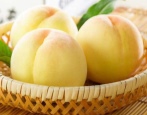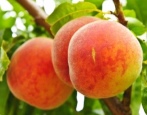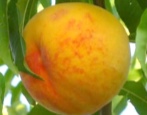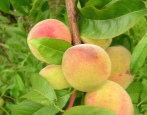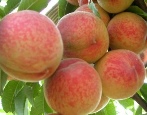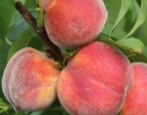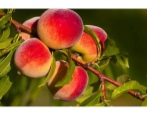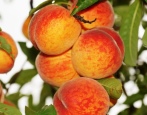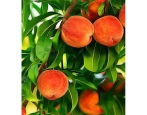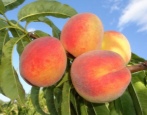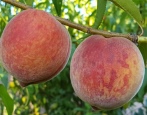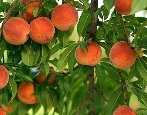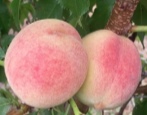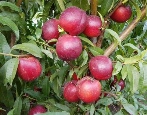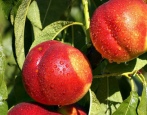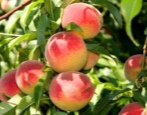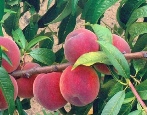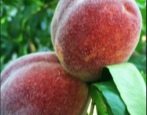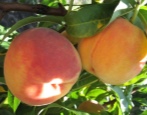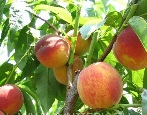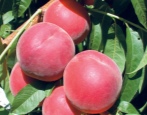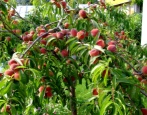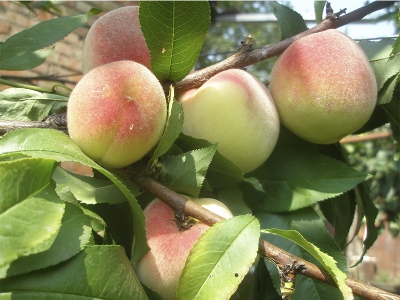
- Authors: Crimean selection, Nikitsky Botanical Garden
- Growth type: medium-sized
- Ripening period: late
- Self-fertility: self-fertile
- Appointment: for fresh consumption, for canning
- Yield: high
- Transportability: good
- Early maturity: begins bearing fruit in the 2nd year
- Bone size: large
- Separability of the bone from the pulp: good
Not every gardener dares to grow peaches. After all, this culture needs special care and is famous for its exactingness. However, there are varieties that are more or less suitable for beginners. One of these subspecies is the Tourist peach.
Description of the variety
Medium-sized trees of the Tourist variety grow no higher than 4 meters. They are quite compact and do not take up much space on the site. The crown of plants is wide, spreading, in shape it is reverse-pyramidal. The foliage is light green with jagged edges. Bell-shaped flowers, painted pink.
Fruit characteristics
Peaches of this variety are rather large in size. They can weigh up to 200 grams. The fruits themselves are greenish-cream, there is a slight raspberry blush. Peaches can be either round or oval. Weak pubescence is visible on the peel.
The pulp has many fibers, it is moderately dense, juicy and crunchy appetizing. Inside the greenish-white content is a large bone, which separates from the pulp without any problems.
The fruits of the Tourist collected from the tree are used universally. They can be eaten fresh and can also be used to make a variety of dishes. Peaches are well transported, but they do not lie too long - from 6 to 8 days.
Taste qualities
Tourist peaches have a pleasant strong aroma and sweet taste.
Ripening and fruiting
The variety begins to bear fruit in the second year after planting. The tree starts flowering in May. It bears fruit late - at the beginning of autumn.
Yield
This variety has no yield problems. By the age of six, the tree begins to bear 30-35 kilograms of fruit. As it matures, it increases performance. The maximum yield per mature tree is 90-100 kg of peaches.
Self-fertility and the need for pollinators
The tourist belongs to self-fertile varieties, he does not need pollinators. However, it is quite reasonable to plant other peach varieties nearby that will bloom with it at the same time. So you can increase the yield several times.
Growing and care
The plant can be planted both in the sun and in partial shade. There should be no strong winds in this area. Loam and sandy loam are suitable from soils. It is also important to control the groundwater: it should not flow too close to the surface.
The best planting option is spring, and the pit may not be prepared in advance. When planting, the soil is mixed with rotten manure (10 kg) and superphosphate (150 g). The planted tree is watered abundantly using 4 to 5 buckets of warm water. Then the trunk circle must be mulched with compost, the layer of which should be 0.1 m.
The peach of the described variety does not resist moisture well. Therefore, watering is carried out depending on weather conditions and the level of soil drying. In addition, the Tourist will need several abundant irrigations per season. This is the time of the dissolution of foliage and buds, the periods of flowering and pouring of the fruits themselves. These three steps will require 3 full buckets of water each. After irrigation, loosening and weeding of the soil is carried out in the near-trunk circle. It is customary to mulch this variety with freshly cut grass.
Trees of the Tourist species are usually grown in the shape of a bowl. For such a shape to appear, it will be necessary to carry out shaping trimming. The first pruning is carried out immediately after planting.During it, the side branches are removed, and the central conductor is shortened so that its top is below the upper side branch.
Also, about 4 skeletal specimens are left, the distance between them should be 0.2 m.In the next season, it is necessary to prune the branches of the first order, or you can simply set the direction of growth for them. In subsequent years, pruning is carried out to improve fruiting, as well as sanitary procedures after winter. In addition, the tree will have to be normalized.
In order for the Tourist to bring rich harvests, the culture must be fed. During early spring, the soil is fertilized with nitrogen. Usually gardeners use urea for this. Take a tablespoon on a bucket of water. In summer, the choice of dressing is more extensive. So, trees love sodium humate (a teaspoon in a bucket of water), bone meal (100 grams per 1 square meter), wood ash (taken with shovels, you need 2-3), complex fertilizing with minerals (according to the instructions). In autumn, potassium sulfate and superphosphate should be used (40 grams per bucket of water).
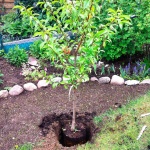
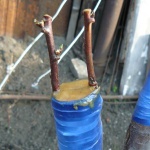
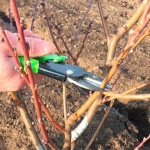
Frost resistance and the need for shelter
The trees of this variety are quite frost-resistant, but in the case of peaches it is always better to play it safe. The tree is spud and thoroughly mulched with fallen leaves or compost. Then they completely wrap it in agrofibre, tie it up. A cloth bag is put on top.
Disease and pest resistance
The tourist is resistant to curliness, clotterosporia and powdery mildew. He may well pick up other diseases. To prevent this from happening, you need to follow the seasonal preventive spraying schedule.
If the tree is attacked by pests, the foliage is allowed to be treated with biological agents. Such drugs are quickly cleared from plant tissues.
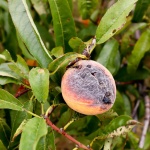
Requirements for soil and climatic conditions
The tree grows only on light and fertile soils, in this regard it is quite capricious. Will not grow on heavy, salty, acidic or alkaline substrates. Despite its southern origin (Crimea), the Tourist does not resist the heat very well. Drought resistance is weak.
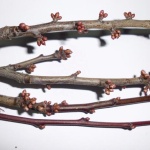
Review overview
Tourist peaches are popular with summer residents for their large size and pleasant sweet taste.The main advantage that they note is the high yields of mature trees. The farmers also like the decent indicators of transportability.
The disadvantages that gardeners mentioned will be as follows: soil requirements, low drought resistance, the likelihood of being affected by diseases and pests.
